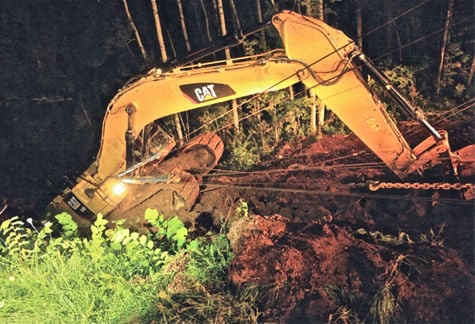
With a network of cables extending to a trio of tow trucks, a 120,000 pound Caterpillar excavator is slowly brought up the banks of Trout Creek were it got stuck while working on the construction of a new bridge to replace a culvert washed out during last July’s flooding. The exploit won Tomlinson Towing a spot on the cover of Towing Times Magazine.
In a career that spanned more than 60 years, Bill Tomlinson has been called on many times to contend with recovery and tow jobs the likes of which most tow operations will never see.
“Our motto has been ‘If it flies, floats or rolls, we can handle it,’” said Tomlinson, who retired from Tomlinson’s Towing in January of 2014 after operating the business since 1966.
He originally bought the business from his father who started it in 1946, and sold it to Dean Zifko, who continues as the business’s current owner.
During his tenure, Tomlinson has an unmatched record of success in recovery and towing.
“We never turned any work down, and we never came home empty,” he said with evident pride. “We had a standing offer — if we don’t pull it, we don’t charge. But we’ve never done one for nothing.”
This summer, as work proceeded at top speed to replace a pair of bridges on State Highway 13, south of Ashland, that record was challenged by a difficult recovery that was literally one for the books.
At about 10 a.m. on Aug. 30, Tomlinson Manager Brenda Hebert got a call from a road crew supervisor asking if the firm could assist in recovering a piece of equipment that had sunk in the mud at the construction site at Trout Brook, near North York, about 16 miles south of Ashland.
“I asked the usual questions,” Hebert said. “Where is it, what’s the problem, what type of equipment? When the supervisor told me it was a 120,000 pound excavator, I sat up straight in my chair”
Hebert asked how deep the excavator had sunk in the mud.
“Real deep,” was the reply.
At first, tow operator Brandon Bowers went to the scene to scope out the problem, only to be told that the construction company would try using their own equipment to haul the stuck excavator out of a 12-foot hole.
“That didn’t work real well,” said Tomlinson. “The only thing they accomplished was sinking it two feet deeper.”.
At that point, the contracting firm admitted defeat and called Tomlinson again.
“Just do what you have to; I need this out,” said the exasperated supervisor.
Zifko began to assemble a recovery team and called on the grand old man of Ashland towing and recovery, Bill Tomlinson, and his son Bob to lend a hand.
When the crew arrived at the scene, one road crew worker looked at the trio of smaller wreckers and snorted derisively “What are you going to do with those Tonka Trucks?”
Bob Tomlinson replied that he aimed to get the excavator out.
The man laughed and told Bob he was wasting his time.
“I’ve never walked away from a job I haven’t finished,” Bob replied.
What Tomlinson knew and the construction crew didn’t understand is that recovery isn’t simply a matter of brute force yanking a vehicle out. Rather it is a symphony of applied pressure in the right spots.
“It’s all about mechanical advantage,” Tomlinson said, recalling the words of the Greek mathematician, physicist and engineer Archimedes who said, “Give me a lever long enough, and a fulcrum on which to place it and I shall move the world.”
“It’s true, there are much larger trucks out there than what we had, but if you don’t know how to run them, they are worthless,” Tomlinson said. “It’s knowing what to do.”
Leverage is the key. The block-and-tackle mechanism of a tow truck uses the law of leverage to increase the power applied to a recovery problem. When the force is spread out over key points, smaller equipment can accomplish amazing results.
“At our annual tool show, we took an empty tractor/trailer and laid it on its side and rigged it up using a block and tackle. Then we had 12 10-year-old kids, six on each line, and they pulled it over by hand,” Tomlinson said.
In this case, using a D-6 Bulldozer as an anchor point and an estimated 19 lines connecting the entire rig, some 253,000 pounds of force was exerted to slowly, oh so slowly, pull the enormous excavator up the hill.
It was a demonstration of how to use applied physics to succeed, but that didn’t mean it was easy.
“In a grade like that, with all that suction, it pulled hard,” Tomlinson said.
In the end, despite a minor setback and some re-rigging, the excavator was brought up out of the hole.
“Everybody was amazed,” Tomlinson said.
The whole exercise had taken just four hours.
Bill and Bob Tomlinson both said it was the biggest job they had ever undertaken.
Word of the tour de force reached Tow Times magazine, the International publication for the towing and recovery industry. They got the story and pictures of the recovery.
“Usually they put pictures of fancy towing trucks on the cover, this time they put the excavator recovery on it,” Bill Tomlinson said.
For a tow and recovery man, getting the cover of Tow Times is akin to making the cover of the Rolling Stone for a rock star.
“I went to the post office and saw the envelope, and I was anxious to see if they had the story in this month, and there it was, right on the cover,” he said. “I was astonished, to say the least. We’ve been in Tow Times a number of times, but never on the front cover.”
Material from Tow Times was used in the creation of this report.
Call us if you need help towing your vehicle
